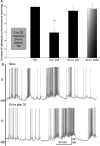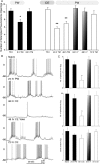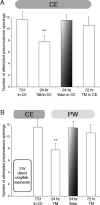Electrophysiological and behavioral evidence demonstrating that predator detection alters adaptive behaviors in the snail Lymnaea
- PMID: 18337402
- PMCID: PMC6670673
- DOI: 10.1523/JNEUROSCI.5132-07.2008
Electrophysiological and behavioral evidence demonstrating that predator detection alters adaptive behaviors in the snail Lymnaea
Abstract
Stress has been shown to both impair and enhance learning, long-term memory (LTM) formation, and/or its recall. The pond snail, Lymnaea stagnalis, both detects and responds to the scent of a crayfish predator with multiple stress-related behavioral responses. Using both behavioral and electrophysiological evidence, this investigation is a first attempt to characterize how an environmentally relevant stressor (scent of a predator) enhances LTM formation in Lymnaea. Using a training procedure that, in "standard" pond water (PW), results in an intermediate-term memory that persists for only 3 h, we found that training snails in "crayfish effluent" (CE) induces a memory that persists for 48 h (i.e., its now an LTM). In addition, if we use a training procedure that in PW produces an LTM that persists for 1 d, we find that snails trained in CE have an LTM that persists for at least 8 d. Furthermore, we describe how a single neuron (RPeD1), which has been shown to be a necessary site for LTM formation, reflects the behavioral changes in its firing properties that persist for the duration of the LTM. Finally, Lymnaea exhibit context-specific memory, that is, when a memory is formed in a specific context (food odorant), it is only recalled in that context. Here, we found that snails trained in CE demonstrate context generalization, that is, memory is recalled in multiple contexts. All data are consistent with the hypothesis that learning in a stressful, yet biologically relevant, environment enhances LTM and prolongs its retention.
Figures





Similar articles
-
Increase in excitability of RPeD11 results in memory enhancement of juvenile and adult Lymnaea stagnalis by predator-induced stress.Neurobiol Learn Mem. 2010 Sep;94(2):269-77. doi: 10.1016/j.nlm.2010.06.005. Epub 2010 Jun 25. Neurobiol Learn Mem. 2010. PMID: 20601028
-
The role of serotonin in the enhancement of long-term memory resulting from predator detection in Lymnaea.J Exp Biol. 2010 Nov 1;213(Pt 21):3603-14. doi: 10.1242/jeb.048256. J Exp Biol. 2010. PMID: 20952608
-
The perception of stress alters adaptive behaviours in Lymnaea stagnalis.J Exp Biol. 2008 Jun;211(Pt 11):1747-56. doi: 10.1242/jeb.014886. J Exp Biol. 2008. PMID: 18490390 Review.
-
Investigating the interactions between multiple memory stores in the pond snail Lymnaea stagnalis.J Comp Physiol A Neuroethol Sens Neural Behav Physiol. 2024 Jan;210(1):91-102. doi: 10.1007/s00359-023-01649-3. Epub 2023 Jul 3. J Comp Physiol A Neuroethol Sens Neural Behav Physiol. 2024. PMID: 37395798
-
Environmentally relevant stressors alter memory formation in the pond snail Lymnaea.J Exp Biol. 2014 Jan 1;217(Pt 1):76-83. doi: 10.1242/jeb.089441. J Exp Biol. 2014. PMID: 24353206 Review.
Cited by
-
How stress alters memory in 'smart' snails.PLoS One. 2012;7(2):e32334. doi: 10.1371/journal.pone.0032334. Epub 2012 Feb 24. PLoS One. 2012. PMID: 22384220 Free PMC article.
-
Fluoride alters feeding and memory in Lymnaea stagnalis.J Comp Physiol A Neuroethol Sens Neural Behav Physiol. 2022 Mar;208(2):267-277. doi: 10.1007/s00359-021-01528-9. Epub 2021 Dec 2. J Comp Physiol A Neuroethol Sens Neural Behav Physiol. 2022. PMID: 34854952
-
Training Lymnaea in the presence of a predator scent results in a long-lasting ability to form enhanced long-term memory.J Comp Physiol A Neuroethol Sens Neural Behav Physiol. 2016 Jun;202(6):399-409. doi: 10.1007/s00359-016-1086-z. Epub 2016 Apr 30. J Comp Physiol A Neuroethol Sens Neural Behav Physiol. 2016. PMID: 27138222
-
Combining stressors that individually impede long-term memory blocks all memory processes.PLoS One. 2013 Nov 6;8(11):e79561. doi: 10.1371/journal.pone.0079561. eCollection 2013. PLoS One. 2013. PMID: 24223180 Free PMC article.
-
An infralimbic cortex engram encoded during learning attenuates fear generalization.J Neurosci. 2025 Mar 27;45(19):e2120242025. doi: 10.1523/JNEUROSCI.2120-24.2025. Online ahead of print. J Neurosci. 2025. PMID: 40147934
References
-
- Abrams P. Should prey overestimate the risk of predation. Am Naturalist. 1994;144:317–328.
-
- Apfelbach R, Blanchard CD, Blanchard RJ, Hayes RA, McGregor IS. The effects of predator odors in mammalian prey species: a review of field and laboratory studies. Neurosci Biobehav Rev. 2005;29:1123–1144. - PubMed
-
- Benjamin PR, Staras K, Kemenes G. A systems approach to the cellular analysis of associative learning in the pond snail Lymnaea . Learn Mem. 2000;7:124–131. - PubMed
-
- Bolhuis JJ, Macphail EM. A critique of the neuroecology of learning and memory. Trends Cogn Sci. 2001;5:426–433. - PubMed
-
- Bremner JD. Hypotheses and controversies related to effects of stress on the hippocampus: an argument for stress-induced damage to the hippocampus in patients with posttraumatic stress disorder. Hippocampus. 2001;11:75–81. discussion 82–74. - PubMed
Publication types
MeSH terms
LinkOut - more resources
Full Text Sources
Research Materials
